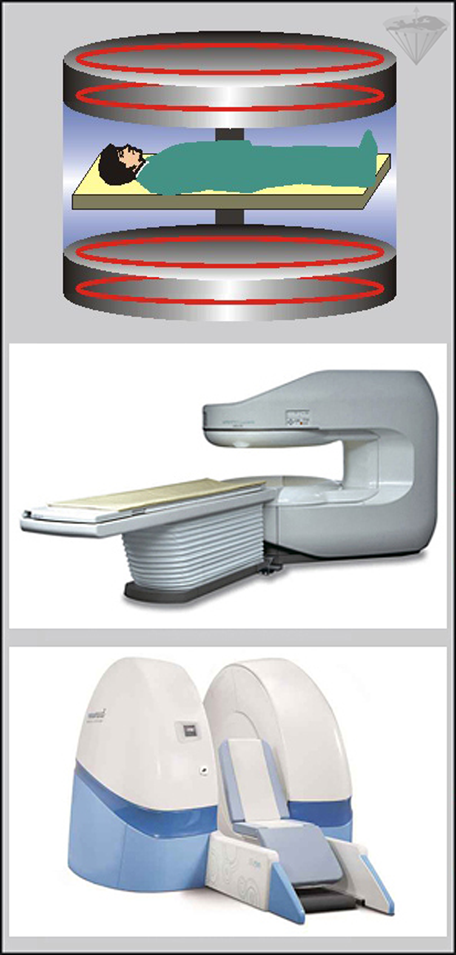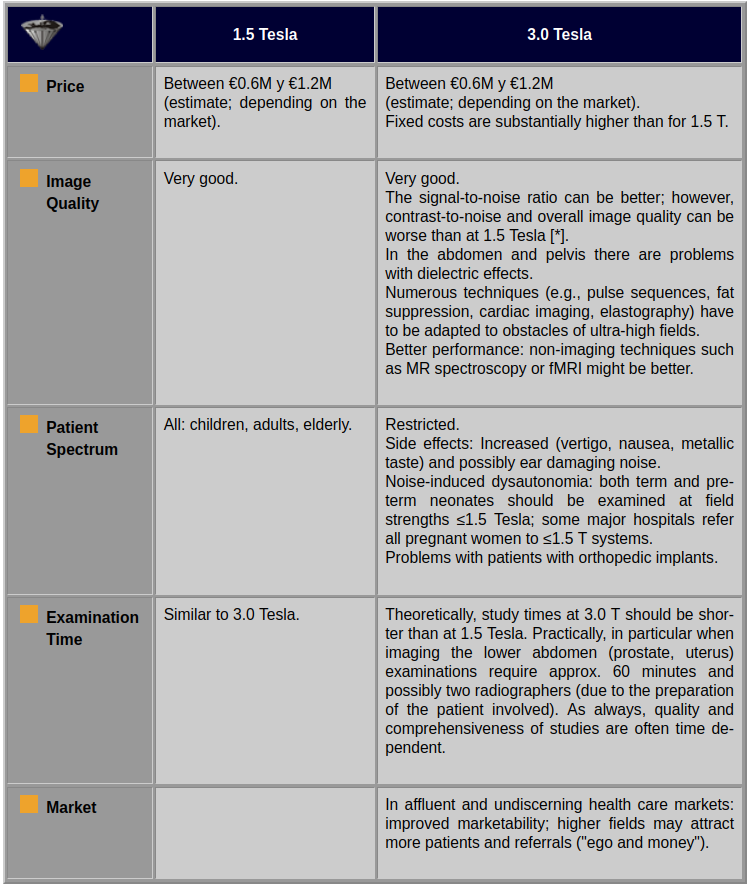





 here are at least 50,000 MR imaging systems operating all over the world, most likely more. MR systems are available in the well-known tunnel shape (Figure 03-08) or as open systems (Figure 03-15).
here are at least 50,000 MR imaging systems operating all over the world, most likely more. MR systems are available in the well-known tunnel shape (Figure 03-08) or as open systems (Figure 03-15).
The traditional donut-shaped machines allow very high field strengths and thus are well suited for research applications and specific techniques. Many of these machines are not very comfortable for patients and annoyingly, partly dangerously loud; the noise of gradient switching can sound like a jackhammer.
During the last two decades machines with larger bores have been developed to lower the rate of claustrophobia and allow studies of obese patients.

Figure 03-15:
Open MR systems. The magnet is separated into two sections above and below or left and right of the patient couch.
Top: Diagram. Center: 1.2 Tesla commercial system. Bottom: 0.5 Tesla commercial system with MgB2 coils.
Open systems reduce patient claustrophobia and are better suited for interventional purposes because there is access to the patient from all sides. Open systems are available between 0.3 T with permanent magnets to 1.5 T with superconducting magnets. Recent developments focus on machines between 0.5 and 1.2 T. They include equipment with MgB2 coils.
Many open systems are quiet, offer more space for handicapped and stout patients — and children.
Dedicated systems are aimed at, e.g., orthopedic imaging (Figure 03-15 bottom). Examinations of knees, elbows, hands, and shoulders are the main indications. These systems are smaller and easier to install.
 The choice of an MR system might be quite agonizing and dependent on subjective reasons, such as hearsay, fashions, money, ego (of both owners and clientèle), character strength, and politics. Field strength is one, but not the only and most important, parameter; higher field strength does not necessarily guarantee a better quality system or better diagnostic outcome for the patient. Image quality can be worse; the intensity of artifacts scales with field strength.
The choice of an MR system might be quite agonizing and dependent on subjective reasons, such as hearsay, fashions, money, ego (of both owners and clientèle), character strength, and politics. Field strength is one, but not the only and most important, parameter; higher field strength does not necessarily guarantee a better quality system or better diagnostic outcome for the patient. Image quality can be worse; the intensity of artifacts scales with field strength.
Beware of weasel words such as "increased diagnostic confidence score"; they are not objective measurements but sales jargon.
Needs must be carefully assessed in the choice of an MR machine. The quality of the component parts, both in terms of hardware and software, has a considerable impact on the equipment. Service, maintenance, and knowledge of how to run the system are of pivotal importance for image quality and assessment. After software failures, gradient problems are the main source of downtime of MR systems.
When contemplating the purchase of an MR imaging machine thoughtful consideration must not only include price, service costs, and reimbursement structure, but also other aspects that are involved in the cost versus benefit calculation, for instance the most likely indications on the user’s side (Figure 21-01).
In the case of 1.5 Tesla versus 3.0 Tesla, one should weigh up the points in Table 03-03. It is unclear whether or not patients will receive different clinical management or experience different health outcomes when examined on an ultrahigh field machine [⇒ Wood 2012].
Never forget: Most clinical questions can be easily answered with a 0.5 Tesla machine.

Table 03-03:
Some additional scientific and non-scientific aspects of 1.5 and 3.0 Tesla magnet systems.
* Modified from: ⇒ Pattany 2004.